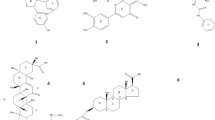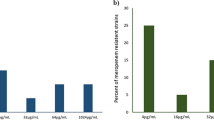Abstract
Bacterial resistance is a natural process carried out by bacteria, which has been considered a public health problem in recent decades. This process can be triggered through the efflux mechanism, which has been extensively studied, mainly related to the use of natural products to inhibit this mechanism. To carry out the present study, the minimum inhibitory concentration (MIC) tests of the compound limonene were performed, through the microdilution methodology in sterile 96-well plates. Tests were also carried out with the association of the compound with ethidium bromide and ciprofloxacin, in addition to the ethidium bromide fluorimetry, and later the molecular docking. From the tests performed, it was possible to observe that the compound limonene presented significant results when associated with ethidium bromide and the antibiotic used. Through the fluorescence emission, it was observed that when associated with the compound limonene, a greater ethidium bromide fluorescence was emitted. Finally, when analyzing the in silico study, it demonstrated that limonene can efficiently fit into the MepA structure. In this way, it is possible to show that limonene can contribute to cases of bacterial resistance through an efflux pump, so that it is necessary to carry out more studies to prove its effects against bacteria carrying an efflux pump and assess the toxicity of the compound.




Similar content being viewed by others
References
Almeida RS, Freitas PR, Araújo ACJ et al (2020) GC-MS profile and enhancement of antibiotic activity by the essential oil of Ocotea odorífera and Safrole: inhibition of Staphylococcus aureus Efflux Pumps. Antibiotics 9:247–262
Araújo A, Freitas P, Barbosa C et al (2021) Modulation of drug resistance by limonene: inhibition of efflux pumps in Staphylococcus aureus Strains RN- 4220 e IS-58. Curr Drug Metab 22:110–113
Araújo ACJd, Freitas PR, Santos Barbosa CRd et al (2020) GC-MS-FID characterization and antibacterial activity of the Mikania cordifolia essential oil and limonene against MDR strains. Food Chem Toxicol 136:111023–111028
Braissant O, Astasov-Frauenhoffer M et al (2020) A review of methods to determine viability, vitality, and metabolic rates in microbiology. Front Microbiol 11:547458–547482
Costa SCNS (2010) Caracterização preliminar da bioenergética do efluxo pelo sistema AcrAB-TolC em Escherichia coli. MSc. Thesis. Universidade Nova de Lisboa, Lisboa, Portugal
Coutinho HD, Costa JG, Lima EO, Falcão-Silva VS, Siqueira-Júnior JPJC (2008) Enhancement of the antibiotic activity against a multiresistant Escherichia coli by Mentha arvensis L. and chlorpromazine. Chemotherapy 54:328–330
Crowell PL (1997) Monoterpenes in breast cancer chemoprevention. Breast Cancer Res Treat 46:191–197
De Marco CE, Cushing LA, Frempong-Manso E et al (2007) Efflux-related resistance to norfloxacin, dyes, and biocides in bloodstream isolates of Staphylococcus aureus. Antimicrob Agents Chemother 51:3235–3239
do Amaral JF, Silva MIG, de Aquino Neto MRA, et al (2007) Antinociceptive effect of the monoterpene R-(+)-limonene in mice. Biol Pharm Bull 30:1217–1220
Foster TJ, Geoghegan JA, Ganesh VK et al (2014) Adhesion, invasion and evasion: the many functions of the surface proteins of Staphylococcus aureus. Nature Rev Microbiol 12:49–62
Houghton P, Howes M-J, Lee C et al (2007) Uses and abuses of in vitro tests in ethnopharmacology: visualizing an elephant. J Ethnopharmacol 110:391–400
Bhardwaj A, Mohanty PJR (2012) Bacterial efflux pumps involved in multidrug resistance and their inhibitors: rejuvinating the antimicrobial chemotherapy. Recent Pat Antiinfect Drug Discov 7:73–89
Kaatz GW, McAleese F, Seo SM (2005) Multidrug resistance in Staphylococcus aureus due to overexpression of a novel multidrug and toxin extrusion (MATE) transport protein. Antimicrob Agents Chemother 49:1857–1864
Karchmer AW (2000) Nosocomial bloodstream infections: organisms, risk factors, and implications. Clin Infect Dis 31 (Supplement_4): S139-S143
Kumar S, Mukherjee MM, Varela MF (2013) Modulation of bacterial multidrug resistance efflux pumps of the major facilitator superfamily. Int J Bacteriol 2013:204141–204157
Littlejohn TG, Paulsen IT, Gillespie MT et al (1992) Substrate specificity and energetics of antiseptic and disinfectant resistance in Staphylococcus aureus. FEMS Microbiol Lett 95:259–265
Loureiro RJ, Roque F, Rodrigues AT et al (2016) O uso de antibióticos e as resistências bacterianas: breves notas sobre a sua evolução. Rev Port Saúde Públ 34:77–84
Mann C, Markham JJ (1998) A new method for determining the minimum inhibitory concentration of essential oils. J Appl Microbiol 84:538–544
Mikulášová M, Chovanová R, Vaverková ŠJPR (2016) Synergism between antibiotics and plant extracts or essential oils with efflux pump inhibitory activity in coping with multidrug-resistant staphylococci. Phytochem Rev 15:651–662
Oliveira MM, Santos HS, Coutinho HD et al (2020) Spectroscopic characterization and efflux pump modulation of a thiophene curcumin derivative. J Mol Struct 1215:128291–128301
Piddock L (2006) Clinically relevant chromosomally encoded multidrug resistance efflux pumps in bacteria. Clin Microbiol Rev 19:382–402
Pinto AC, Silva DHS, Bolzani VdS et al (2002) Produtos naturais: atualidade, desafios e perspectivas. Quím Nova 25:45–61
Rezende-Júnior LM, Andrade LMdS, Leal ALAB et al (2020) Chalcones Isolated from Arrabidaea brachypoda Flowers as Inhibitors of NorA and MepA multidrug efflux pumps of Staphylococcus aureus. Antibiotics 9:351–363
Schindler BD, Jacinto P, Kaatz G (2013) Inhibition of drug efflux pumps in Staphylococcus aureus: current status of potentiating existing antibiotics. Future Microbiol 8:491–507
Seukep AJ, Kuete V, Nahar L et al (2019) Plant-derived secondary metabolites as the main source of efflux pump inhibitors and methods for identification. J Pharm Anal 10:277–290
Tintino SR, de Souza VC, Silva J et al (2020) Effect of vitamin K3 inhibiting the function of NorA efflux pump and its gene expression on Staphylococcus aureus. Membranes 10:130–148
Tintino SR, Oliveira-Tintino CD, Campina FF et al (2018) Vitamin K enhances the effect of antibiotics inhibiting the efflux pumps of Staphylococcus aureus strains. Med Chem Res 27:261–267
Tong SY, Davis JS, Eichenberger E et al (2015) Staphylococcus aureus infections: epidemiology, pathophysiology, clinical manifestations, and management. Clin Microbiol Rev 28:603–661
Tortora GJ, Case CL, Funke BR (2016) Microbiologia-12ª Edição. Artmed Editora. Rio de Janeiro-RJ, Brasil
Van Bambeke F, Lee VJ (2006) Inhibitors of bacterial efflux pumps as adjuvants in antibiotic treatments and diagnostic tools for detection of resistance by efflux. Recent Pat Antiinfect Drug Discov 1:157–175
Viegas Júnior C, Bolzani VdS, Barreiro EJ (2006) Os produtos naturais e a química medicinal moderna. Quím Nova 29:326–337
Viveiros M, Martins A, Paixão L et al (2008) Demonstration of intrinsic efflux activity of Escherichia coli K-12 AG100 by an automated ethidium bromide method. Int J Antimicrob Agents 31:458–462
Author information
Authors and Affiliations
Corresponding author
Additional information
Publisher's Note
Springer Nature remains neutral with regard to jurisdictional claims in published maps and institutional affiliations.
Rights and permissions
About this article
Cite this article
Freitas, P.R., de Araújo, A.C.J., dos Santos Barbosa, C.R. et al. Inhibition of the MepA efflux pump by limonene demonstrated by in vitro and in silico methods. Folia Microbiol 67, 15–20 (2022). https://doi.org/10.1007/s12223-021-00909-6
Received:
Accepted:
Published:
Issue Date:
DOI: https://doi.org/10.1007/s12223-021-00909-6




